Abstract
An extensive study of the epidemiological and serological characteristics of Mycoplasma pneumoniae infection was carried out in a military population. There was an increase in the infection rate at Camp Lejeune during the summer months as indicated by a relative increase in isolations, seroconversions, and hospitalizations for M. pneumoniae pneumonia. Twenty-three percent of the trainees who later became infected had detectable, pre-existing antilipid antibody to M. pneumoniae. When the whole organism was used as antigen, a pre-existing complement fixation (CF) titer of 1:4 or greater correlated with resistance to M. pneumoniae disease as defined by the absence of a fourfold rise in CF antibody, shedding of organisms, and clinical illness. Pre-existing antilipid fraction CF antibody titers of 1:16 or greater correlated with protection against mild and severe M. pneumoniae disease. Antilipid CF antibody titers of 1:4 and 1:8 were related to protection against mild disease but were not associated with protection against pneumonia which required hospitalization. The severity of illness was directly related to the CF antibody response in trainees with acute respiratory disease and pneumonia due to M. pneumoniae. The findings provide a basis for the development of a M. pneumoniae vaccine.
Full text
PDF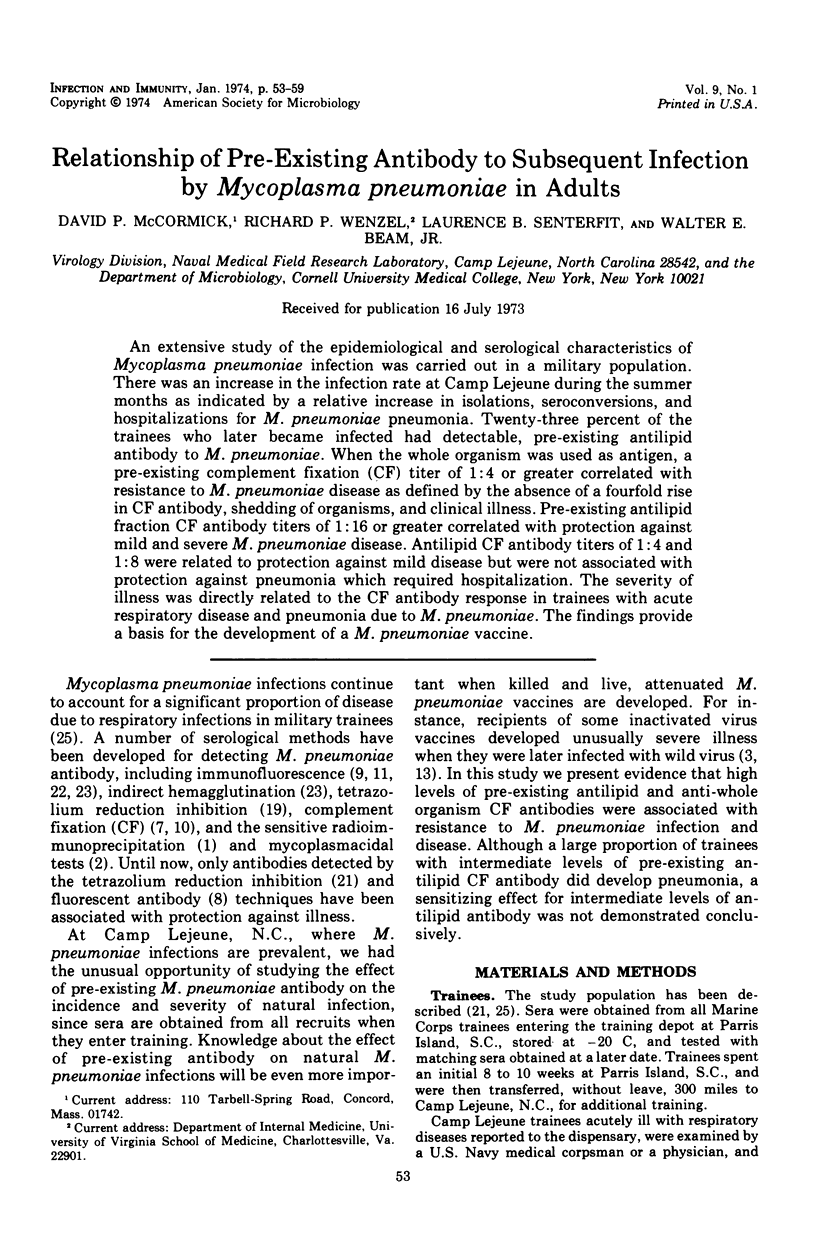
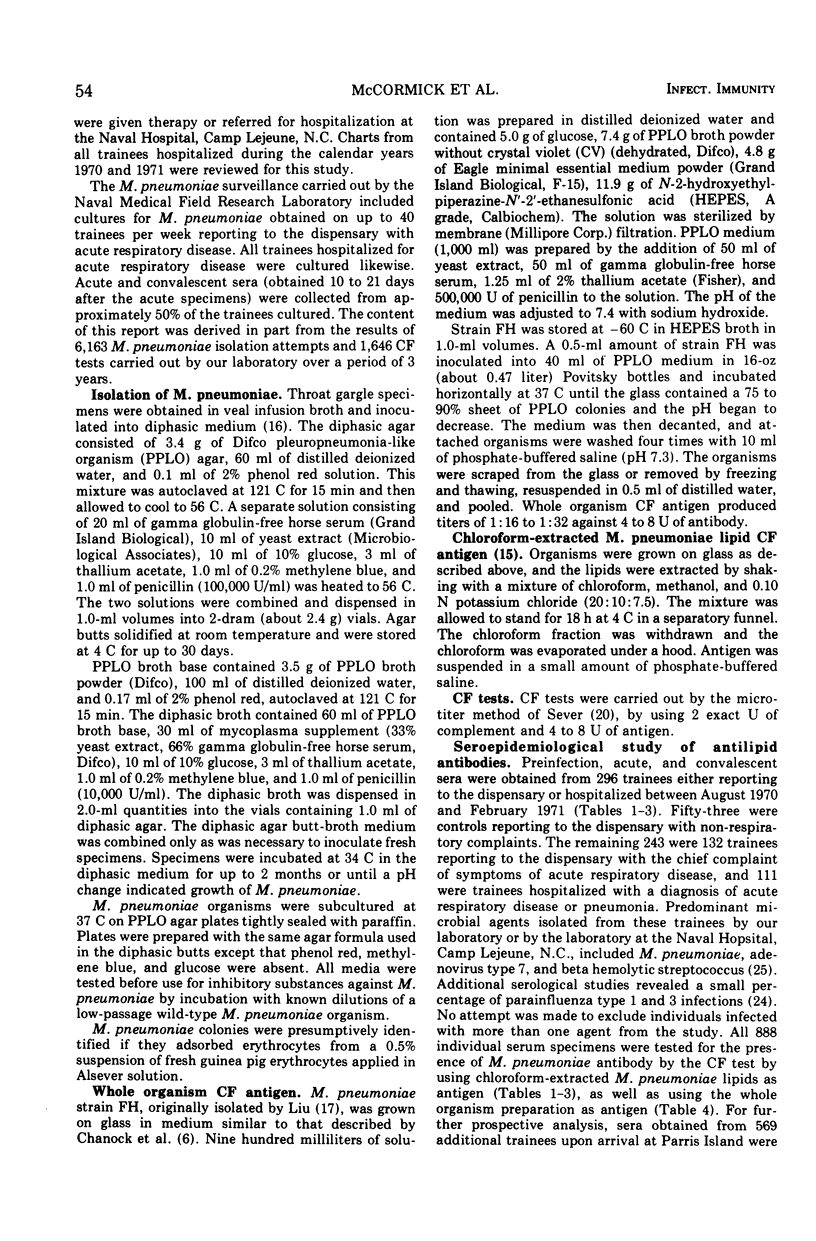
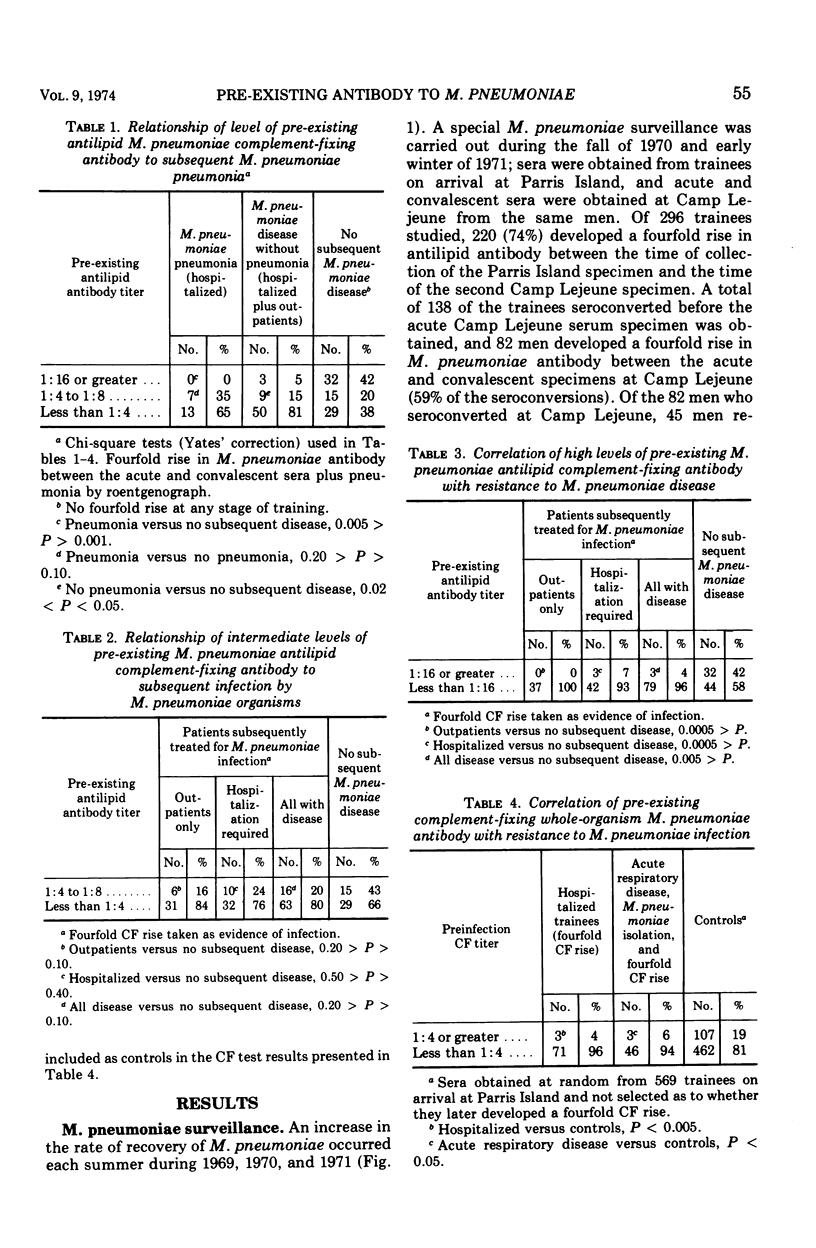
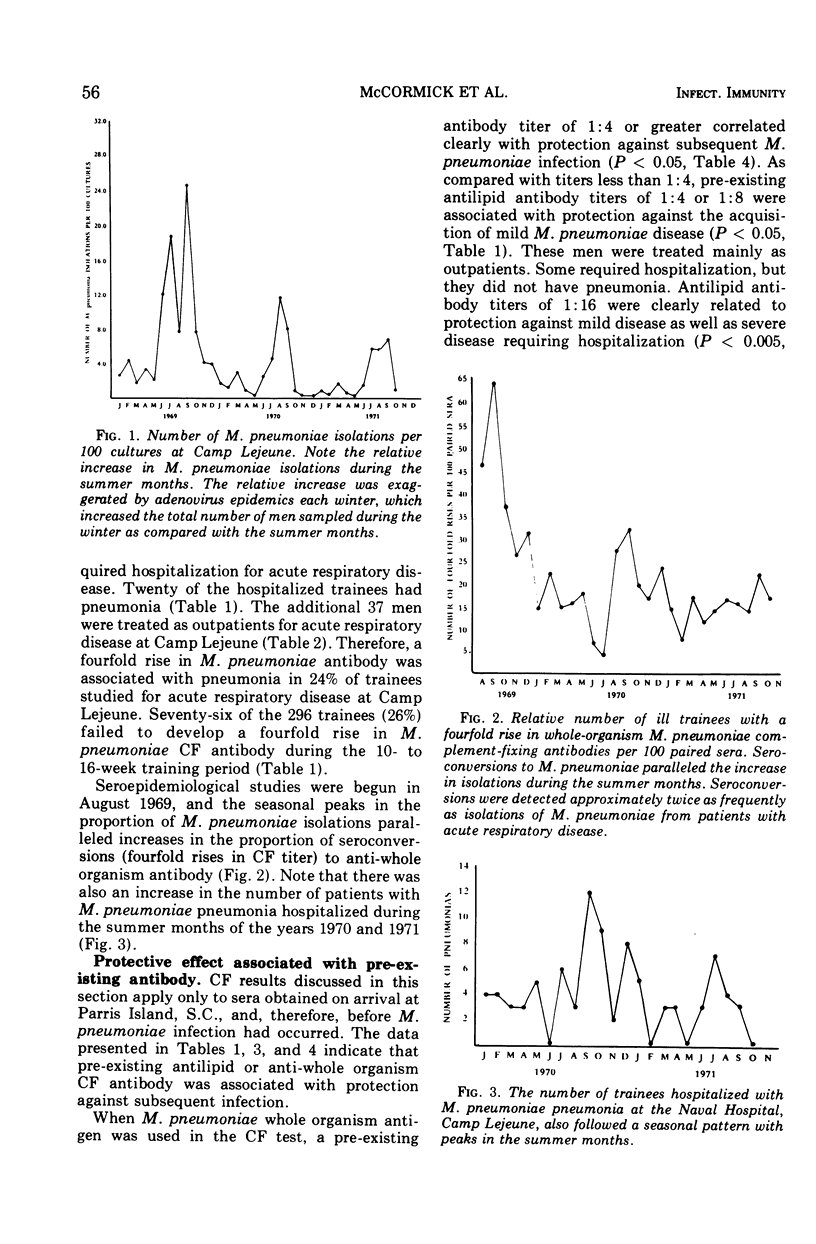
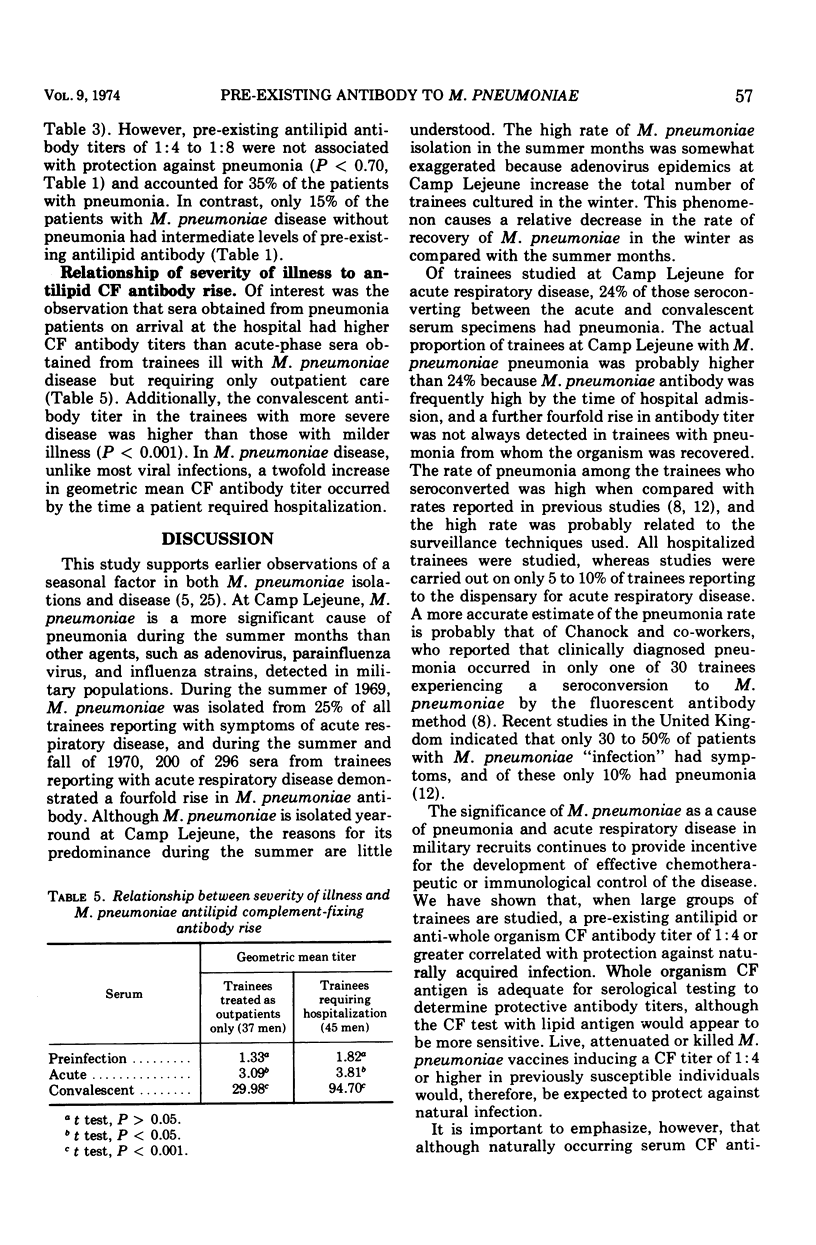
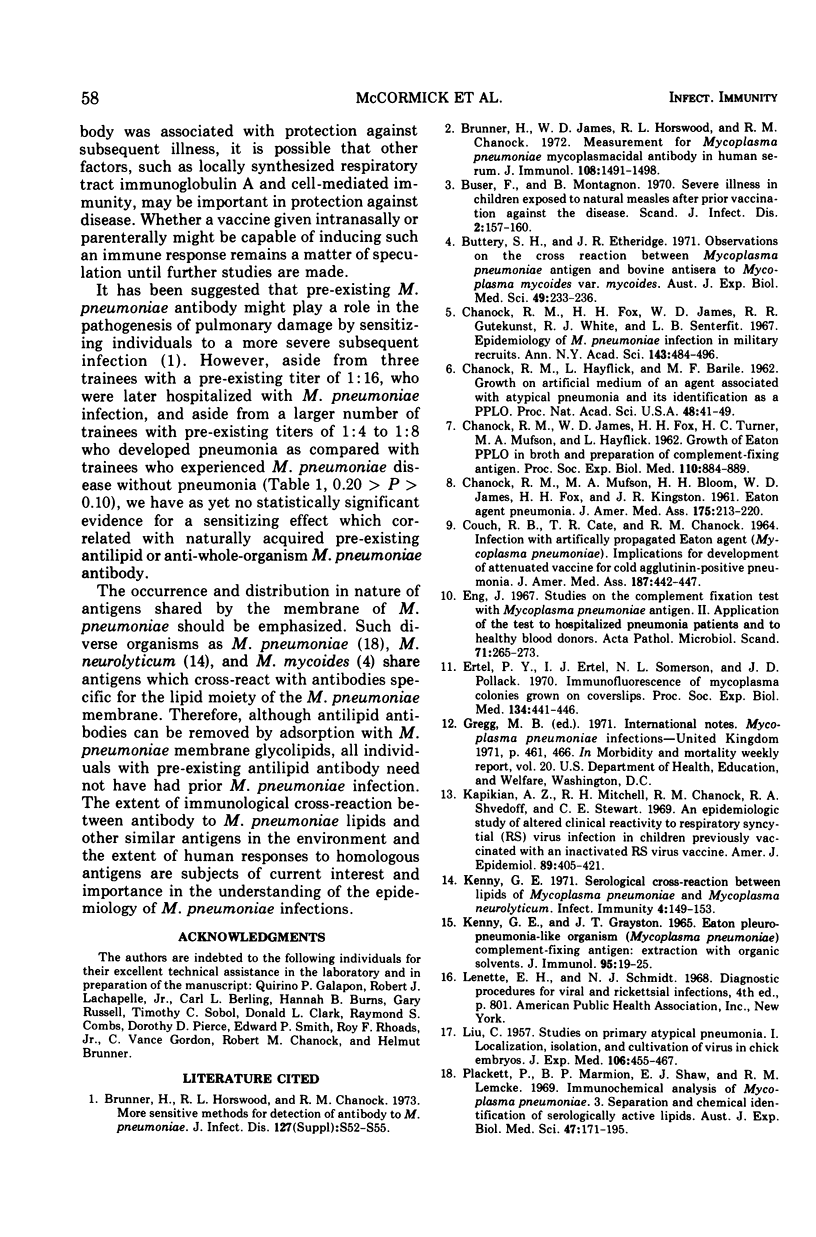
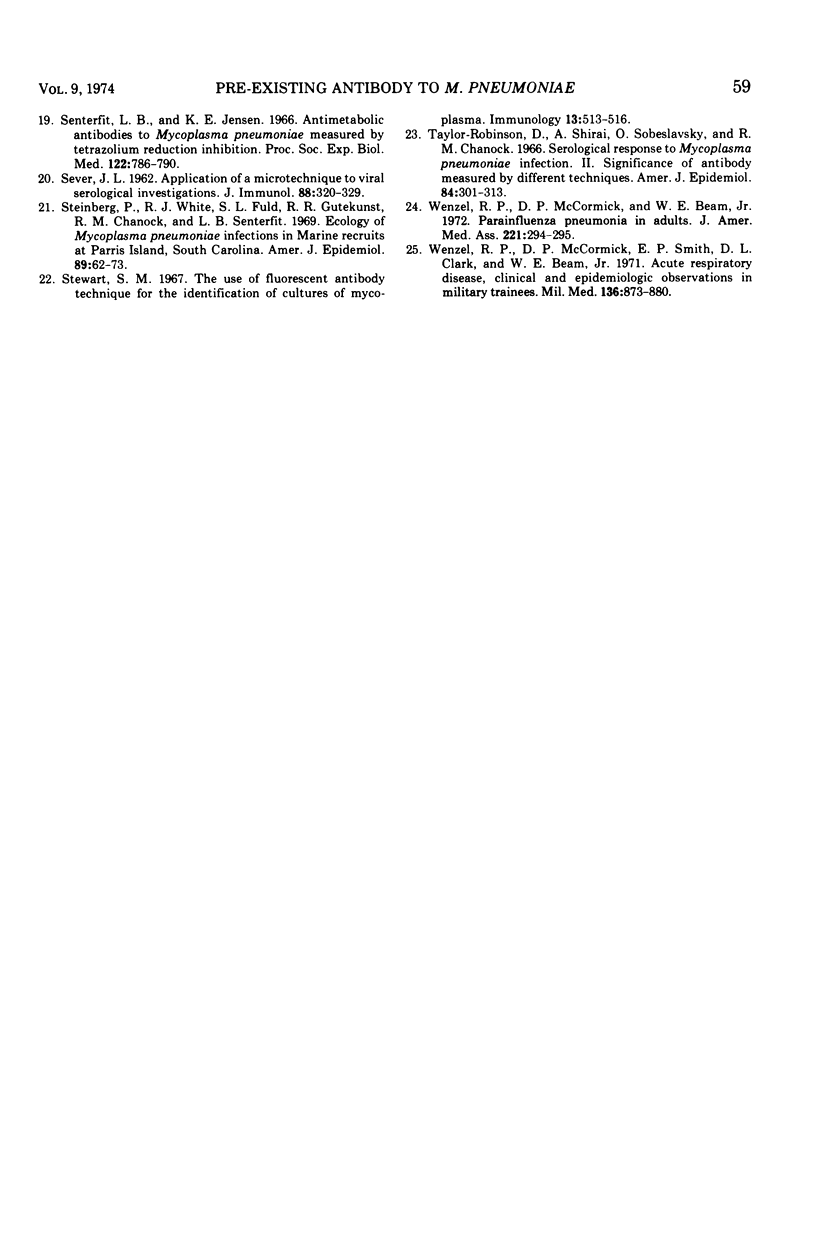
Selected References
These references are in PubMed. This may not be the complete list of references from this article.
- Brunner H., Horswood R. L., Chanock R. M. More sensitive methods for detection of antibody to Mycoplasma pneumoniae. J Infect Dis. 1973 Mar;127(Suppl):S52–S55. doi: 10.1093/infdis/127.supplement_1.s52. [DOI] [PubMed] [Google Scholar]
- Brunner H., James W. D., Horswood R. L., Chanock R. M. Measurement of Mycoplasma pneumoniae mycoplasmacidal antibody in human serum. J Immunol. 1972 Jun;108(6):1491–1498. [PubMed] [Google Scholar]
- Buttery S. H., Etheridge J. R. Observations on the cross reaction between Mycoplasma pneumoniae antigen and bovine antisera to Mycoplasma mycoides var. mycoides. Aust J Exp Biol Med Sci. 1971 Apr;49(2):233–236. doi: 10.1038/icb.1971.21. [DOI] [PubMed] [Google Scholar]
- CHANOCK R. M., HAYFLICK L., BARILE M. F. Growth on artificial medium of an agent associated with atypical pneumonia and its identification as a PPLO. Proc Natl Acad Sci U S A. 1962 Jan 15;48:41–49. doi: 10.1073/pnas.48.1.41. [DOI] [PMC free article] [PubMed] [Google Scholar]
- CHANOCK R. M., JAMES W. D., FOX H. H., TURNER H. C., MUFSON M. A., HAYFLICK L. Growth of Eaton PPLO in broth and preparation of complement fixing antigen. Proc Soc Exp Biol Med. 1962 Aug-Sep;110:884–889. doi: 10.3181/00379727-110-27681. [DOI] [PubMed] [Google Scholar]
- CHANOCK R. M., MUFSON M. A., BLOOM H. H., JAMES W. D., FOX H. H., KINGSTON J. R. Eaton agent pneumonia. JAMA. 1961 Jan 21;175:213–220. doi: 10.1001/jama.1961.03040030037007. [DOI] [PubMed] [Google Scholar]
- COUCH R. B., CATE T. R., CHANOCK R. M. INFECTION WITH ARTIFICIALLY PROPAGATED EATON AGENT (MYCOPLASMA PNEUMONIAE). IMPLICATIONS FOR DEVELOPMENT OF ATTENUATED VACCINE FOR COLD AGGLUTININ-POSITIVE PNEUMONIA. JAMA. 1964 Feb 8;187:442–447. [PubMed] [Google Scholar]
- Chanock R. M., Fox H. H., James W. D., Gutekunst R. R., White R. J., Senterfit L. B. Epidemiology of M. pneumoniae infection in military recruits. Ann N Y Acad Sci. 1967 Jul 28;143(1):484–496. doi: 10.1111/j.1749-6632.1967.tb27692.x. [DOI] [PubMed] [Google Scholar]
- ENNY G. E., GRAYSTON J. T. EATON PLEUROPNEUMONIA-LIKE ORGANISM (MYCOPLASMA PNEUMONIAE) COMPLEMENT-FIXING ANTIGEN: EXTRACTION WITH ORGANIC SOLVENTS. J Immunol. 1965 Jul;95:19–25. [PubMed] [Google Scholar]
- Eng J. Studies on the complement fixation test with Mycoplasma pneumoniae antigen. 2. Application of the test to hospitalized pneumonia patients and to healthy blood donors. Acta Pathol Microbiol Scand. 1967;71(2):265–273. [PubMed] [Google Scholar]
- Ertel P. Y., Ertel I. J., Somerson N. L., Pollack J. D. Immunofluorescence of mycoplasma colonies grown on coverslips. Proc Soc Exp Biol Med. 1970 Jun;134(2):441–446. doi: 10.3181/00379727-134-34809. [DOI] [PubMed] [Google Scholar]
- Kapikian A. Z., Mitchell R. H., Chanock R. M., Shvedoff R. A., Stewart C. E. An epidemiologic study of altered clinical reactivity to respiratory syncytial (RS) virus infection in children previously vaccinated with an inactivated RS virus vaccine. Am J Epidemiol. 1969 Apr;89(4):405–421. doi: 10.1093/oxfordjournals.aje.a120954. [DOI] [PubMed] [Google Scholar]
- Kenny G. E. Serological cross-reaction between lipids of Mycoplasma pneumoniae and Mycoplasma neurolyticum. Infect Immun. 1971 Aug;4(2):149–153. doi: 10.1128/iai.4.2.149-153.1971. [DOI] [PMC free article] [PubMed] [Google Scholar]
- LIU C. Studies on primary atypical pneumonia. I. Localization, isolation, and cultivation of a virus in chick embryos. J Exp Med. 1957 Oct 1;106(4):455–466. doi: 10.1084/jem.106.4.455. [DOI] [PMC free article] [PubMed] [Google Scholar]
- Plackett P., Marmion B. P., Shaw E. J., Lemcke R. M. Immunochemical analysis of Mycoplasma pneumoniae. 3. Separation and chemical identification of serologically active lipids. Aust J Exp Biol Med Sci. 1969 Apr;47(2):171–195. doi: 10.1038/icb.1969.19. [DOI] [PubMed] [Google Scholar]
- SEVER J. L. Application of a microtechnique to viral serological investigations. J Immunol. 1962 Mar;88:320–329. [PubMed] [Google Scholar]
- Senterfit L. B., Jensen K. E. Antimetabolic antibodies to Mycoplasma pneumoniae measured by tetrazolium reduction inhibition. Proc Soc Exp Biol Med. 1966 Jul;122(3):786–790. doi: 10.3181/00379727-122-31252. [DOI] [PubMed] [Google Scholar]
- Steinberg P., White R. J., Fuld S. L., Gutekunst R. R., Chanock R. M., Senterfit L. B. Ecology of Mycoplasma pneumoniae infections in marine recruits at Parris Island, South Carolina. Am J Epidemiol. 1969 Jan;89(1):62–73. doi: 10.1093/oxfordjournals.aje.a120916. [DOI] [PubMed] [Google Scholar]
- Stewart S. M. The use of fluorescent-antibody technique for the identification of cultures of Mycoplasma. Immunology. 1967 Nov;13(5):513–516. [PMC free article] [PubMed] [Google Scholar]
- Taylor-Robinson D., Shirai A., Sobeslavský O., Chanock R. M. Serologic response to Myocplasma pneumoniae infection. II. Significance of antibody measured by different techniques. Am J Epidemiol. 1966 Sep;84(2):301–313. doi: 10.1093/oxfordjournals.aje.a120644. [DOI] [PubMed] [Google Scholar]
- Wenzel R. P., McCormick D. P., Beam W. E., Jr Parainfluenza pneumonia in adults. JAMA. 1972 Jul 17;221(3):294–295. [PubMed] [Google Scholar]
- Wenzel R. P., McCormick D. P., Smith E. P., Clark D. L., Beam W. E., Jr Acute respiratory disease: clinical and epidemiologic observations of military trainees. Mil Med. 1971 Dec;136(12):873–880. [PubMed] [Google Scholar]


